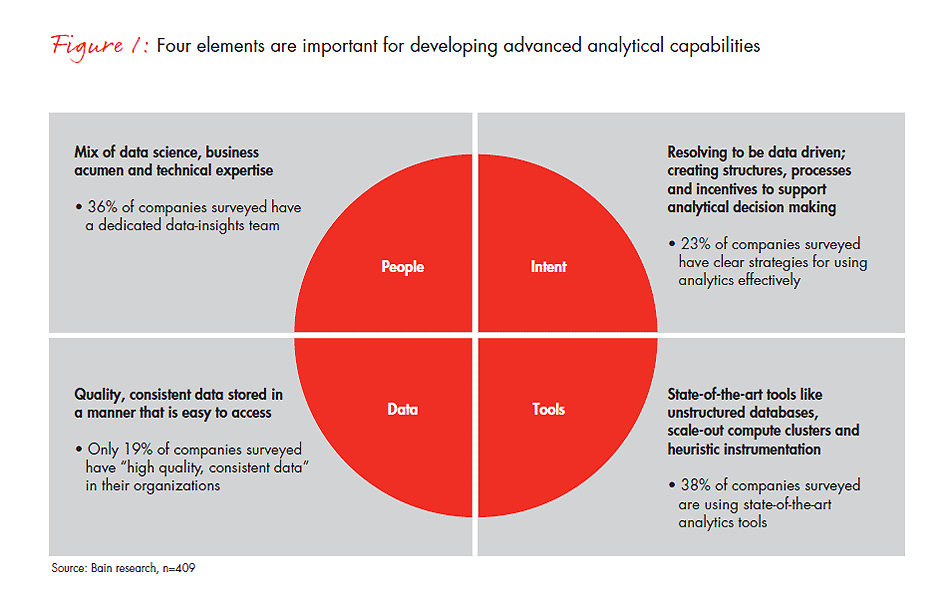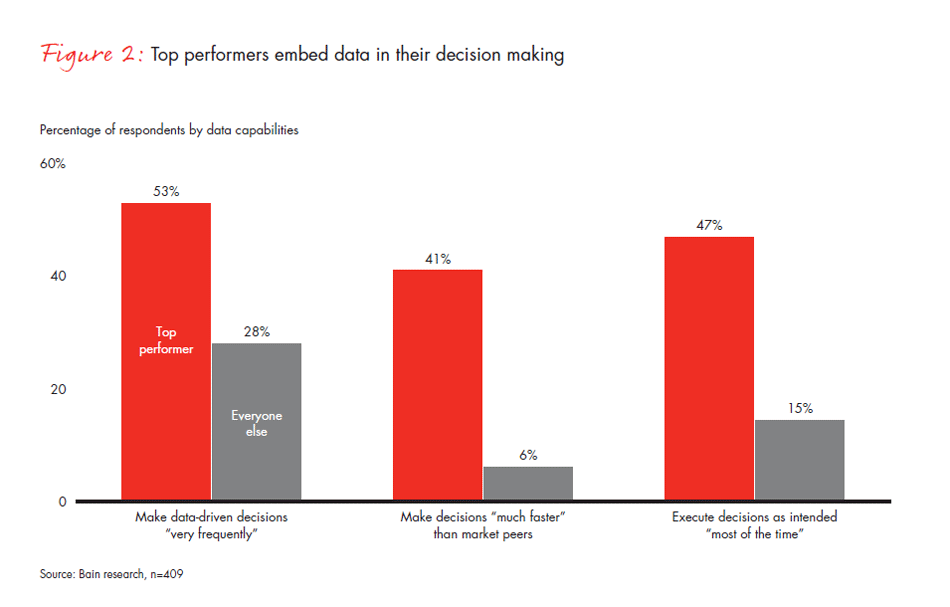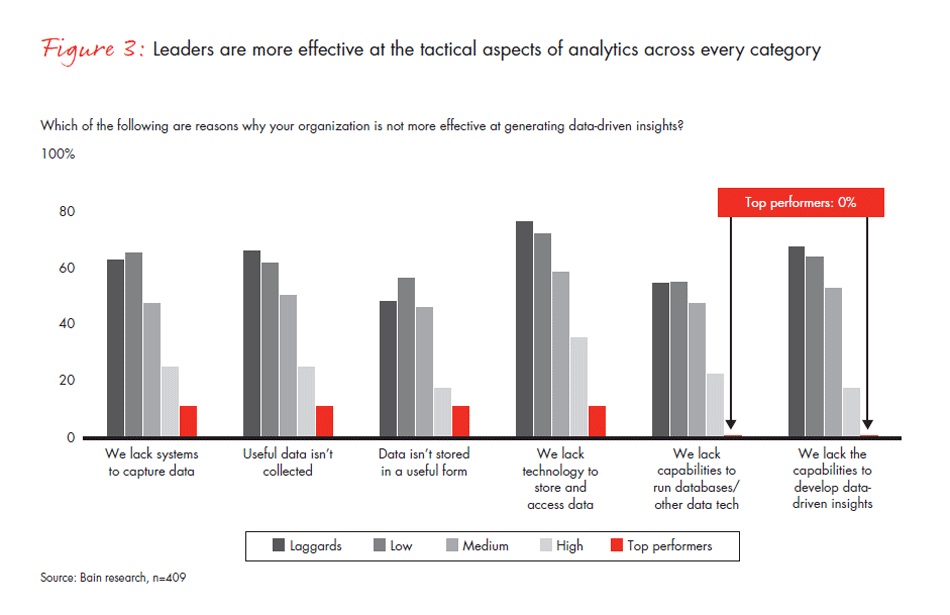Brief
Big Data is quickly becoming a critically important driver of business success across sectors, but many executives say they don’t think their companies are equipped to make the most of it. Bain & Company surveyed executives at more than 400 companies around the world, most with revenues of more than $1 billion. We asked them about their data and analytics capabilities and about their decision-making speed and effectiveness.
The results were surprising: We found that only 4% of companies are really good at analytics, an elite group that puts into play the right people, tools, data and intentional focus. These are the companies that are already using analytics insights to change the way they operate or to improve their products and services. And the difference is already visible. These companies are:
- Twice as likely to be in the top quartile of financial performance within their industries
- Three times more likely to execute decisions as intended
- Five times more likely to make decisions faster
As we describe in a companion brief, “Big Data: The organizational challenge,” achieving competency in Big Data is a three-part process that requires setting the ambition, building up the analytics capability and organizing your company to make the most of the opportunity. This brief looks more closely at the second step—building up the analytics capability—to see how leaders use Big Data to get ahead.
Data, tools, people and intent
Leaders build up their analytics capabilities by investing in four things: data-savvy people, quality data, state-of-the-art tools, and processes and incentives that support analytical decision making (see Figure 1). About a third of companies don’t do any of these well, and many of the rest excel in only one or two areas. But to build a high-performing analytics machine, you need to do all four well. Success in each capability depends on strength in the others.

Data. Companies need a strategic plan for collecting and organizing data, one that aligns with the business strategy of how they will use that data to create value. In our analytics survey, 56% of the companies didn’t have the right systems to capture the data they needed or weren’t collecting useful data, and 66% lacked the right technology to store and access data. A good data policy identifies relevant data sources and builds a data view on the business in order to—and this is the critical part—differentiate your company’s analytics capabilities and perspective from competitors. A critical aspect of good data policy is to focus on identifying relevant sources of data. For example, capturing all queries made on the company website or from customer support calls, emails or chat lines, regardless of their outcome, may have significant value in identifying emerging trends; however, keeping detailed logs of requests that were easily handled might be less valuable.
Tools. Aim high in your aspirations of what’s possible. Advanced analytics and Big Data tools are developing so rapidly that they’re likely to help you get to potential insights and statistical novelties in ways that were not possible even as recently as a year ago. Tools and platforms like Hadoop, HPCC and NoSQL are rapidly emerging and evolving to address analytics opportunities, as is the rich ecosystem of mature analytics, visualization and data management. Today, these tools are available from a wide range of vendors and an even larger community of open-source developers. Still, and somewhat surprising, in our survey, only 38% of companies said they were using any of these.
People. In our survey, 56% of executives said their companies lacked the capabilities to develop deep, data-driven insights. Most agreed they were not up to the challenges of identifying and prioritizing what types of insights would be most relevant to the business. Successful analytics teams build those capabilities by blending data, technical and business talent. Think of a band as the model: a team with different but overlapping skills that knows how to effectively and efficiently communicate and collaborate. Successful Big Data and analytics efforts need:
- Data scientists, who provide expertise in statistics, correlations and quality;
- Business analysts, who identify and prioritize the problems worth solving and the business relevance of data anomalies and patterns identified by the data scientists;
- Technical specialists, who help manage the hardware and software solutions needed to collect, clean and process the data;
Organizational intent. Leading companies embed analytics into their organizations by resolving to be data driven and defining what they hope to accomplish through their use of Big Data. The CEO and top leadership team need to describe how analytics will shape the business’s performance, whether by improving existing products and services, optimizing internal processes, building new products or service offerings, or transforming business models. Top-performing organizations do this well, often building their organizations around data and a commitment to make data-driven decisions (see Figure 2).

Nest is a good example of a company that built into its business model the intent to learn from advanced analytics and Big Data. Other companies offer their customers the ability to remotely control their home thermostats through a Web interface or their smart phones. Nest goes further, crowdsourcing intelligence about when and how customers adjust their thermostats to keep their homes comfortable. Nest gathers that information in the cloud, and by correlating it with weather, location, type of home and when people adjust their thermostats, the company can anticipate and control the settings to create a more comfortable environment in their customers’ homes. Committing to excellence in each of these four categories can require dramatic changes, significant investment and occasionally a change in leadership. But it’s no good focusing on one of these four areas without the other three. Tools won’t help if the data is of poor quality, and talent will walk if the company isn’t committed to benefiting from the insights. Like an engine that must be firing on all pistons, all four areas must be tuned for peak performance.
The opportunity, the urgency
The opportunity to deploy advanced analytics to outperform the competition is real, and top-performing companies see themselves as more effective in every aspect of analytics, including capturing, collecting and storing data, as well as parsing and drawing insights from it (see Figure 3).

Some industries are farther along than others—financial services, technology and healthcare, for example, are leading players in redefining the battlegrounds and business models, based on their analytics capabilities and insight-driven decisions. But opportunities exist in almost every industry. Consider the mail-order pharmacy that analyzed hundreds of thousands of customer service logs and detected a spike in calls between Days 75 and 105 of some patients’ medication regimens. Looking closer, analysts found that the calls correlated with refill dates, and they discovered that some customers were calling for refills because their medications were taken with variable dosages. To reduce the number of lengthy customer service calls and expensive “emergency” refills and rush orders, the pharmacy began asking patients how many pills they had remaining at Day 30 and Day 60, so that they could better predict when the medication would run out.
And within any industry, some functions can benefit from insights gleaned through Big Data analytics. Call centers, for instance, can be made more effective and efficient by capitalizing on what the company can know about the caller ahead of time. And airlines have for years been able to route premium-status fliers to higher-level customer service representatives by recognizing their caller IDs. Now they can do even more: By making a quick correlation between your ID, your booked flights and the status of those flights, they may be able to determine why you’re calling, even before the second ring. If your next flight has just been delayed, the representative could answer the phone with a pretty good idea of why you’re calling. More in-depth analysis could correlate your ID with your social media presence. If you’ve just tweeted an irate message about being booted from a flight, the rep answering your call may have already read it.
More sophisticated still, new technologies like sentiment analysis can use pattern recognition to detect a caller’s mood at the start of a call. An exasperated caller might be quickly routed to a specialist in kid-glove management.
The competitive edge to be gained from advanced analytics is no longer limited to a few techy companies or data-intensive industries. It’s here today, in all sectors, and as our survey results demonstrate, companies that commit to making the most of their data and investing in their analytics capabilities are already outperforming their peers financially. A wait-and-see attitude is a luxury that no competitive company can afford.
Rasmus Wegener is a partner with Bain & Company in Atlanta, and Velu Sinha is a Bain partner in Silicon Valley. Both work with the fi rm’s Global Technology practice.
The authors would like to acknowledge the contributions of James Dillard, a consultant with Bain & Company in Atlanta.


